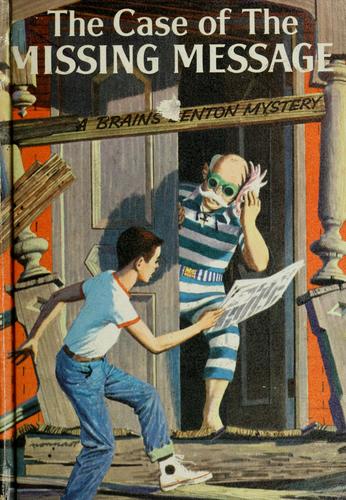AvonVilla reviewed The case of the missing message by Charles Spain Verral (A Brains Benton mystery -- 1)
A High Point in Bubblegum Fiction
5 stars
The existence of the "bubblegum fiction" genre and the claim that this book is a high point in it are both assertions by me, unsupported by anyone else to my knowledge. My enjoyment of "The Case of the Missing Message" is strongly influenced by nostalgia. Your mileage may vary.
I borrowed the "bubblegum" concept from the pop music phenomenon which flowered in the 1960s, where producers and faceless session musicians would make records. THey would then sign up a band of ambitious puppets to be the face of the synthetic creation, lip-synching in TV appearances and posing for cover photos, promoting someone else's music, but putting up with it while enjoying the fringe benefits of fame.
The literary equivalent of this commercial exploitation model was pioneered by the Stratemeyer Syndicate. I am impressed to read that it began pumping out product in the 19th century, but its more famous output …
The existence of the "bubblegum fiction" genre and the claim that this book is a high point in it are both assertions by me, unsupported by anyone else to my knowledge. My enjoyment of "The Case of the Missing Message" is strongly influenced by nostalgia. Your mileage may vary.
I borrowed the "bubblegum" concept from the pop music phenomenon which flowered in the 1960s, where producers and faceless session musicians would make records. THey would then sign up a band of ambitious puppets to be the face of the synthetic creation, lip-synching in TV appearances and posing for cover photos, promoting someone else's music, but putting up with it while enjoying the fringe benefits of fame.
The literary equivalent of this commercial exploitation model was pioneered by the Stratemeyer Syndicate. I am impressed to read that it began pumping out product in the 19th century, but its more famous output came later: The Hardy Boys, Nancy Drew and Tom Swift were among its hot properties. Each series was attributed to a pseudonymous author, but the books were all ghostwritten by staff hacks or freelancers, following a format dictated by the publisher. Also in this vein, Robert Arthur's "Three Investigators" series was a favourite of mine in the 1970s. The commercial innovation here was to leave out the author's name and replace it with the film director Alfred Hitchcock, who "presents" the books rather than writes them. It is notable that Arthur's creation has some strong similarities to the Brains Benton mysteries which preceded it by several years.
The marketing model was paralleled by actual authors in the conventional publishing system. Enid Blyton springs to mind as a prominent exponent of formulaic fiction. Charles Spain Verral seems to sit somewhere in the middle of the spectrum, in terms of facelessness versus fame.
"The Case of the Missing Message" was written in 1959. I have a particular fondness for this book because it was one of my very earliest reading pleasures. My childhood copy was the "Golden Press" edition, with illustrations by the French artist Jacques Pecnard. I was too young to read it in the 60s, but at some stage in the early 1970s I devoured it. I didn't know the author's name. Only later research would reveal it: Charles Spain Verral. On this modern re-reading, I have the Whitman edition which does credit the author, but not on the cover.
The book is a lively and engaging story of two boy detectives who stumble upon a plot by a villainous cove to kidnap the heir to a successful traveling circus, and steal his birthright. The two main characters are an interesting period study... Jimmy Carson is the narrator, an average fifties boy who likes sport and has a paper round. He is a wide-eyed innocent, the type who would say "gee whiz", although his catchphrase when expressing surprise is "creeps!" Jimmy's best friend is Brains Benton, a teenage uber nerd, cross-bred in a literary test tube with Sherlock Holmes.
Brains really is the star of the show, although he's not allowed to have much personality, especially compared to Jimmy, whose narrator's voice rings out clearly. Modern readers might detect a hint of the autism spectrum about Brains, but it seems highly unlikely the author would have had such intent. Happily, Brains is also courageous, moral, and most definitely the leader to whom all other characters defer. I find myself ruefully comparing this to the 21st century, when expertise is derided, science is denied, and a worldwide plague of ignorance, cruelty and greed has broken out in seats of government and state houses around the world.
By contrast, in 1959, in the middle of the nuclear age, and at the dawn of the space age, there was a better class of geek, and they were afforded an appropriate level of deference. In Verral's depiction of the repressed 1950s, there isn't much affection... relationsips are based on loyalty and established modes of behaviour, including rather strict adherence to gender roles and the exclusion of girls and women from the action. Soon, though, the young denizens of this idyllic period would come of age and learn that all you need is love. Or so I like to believe.
The book is dedicated "To Charlie and Randy, for inspiration". Charlie is the author's son, and Randy was his school friend. I take this to be a sign that Verral was perhaps more attached to the story than the "bubblegum" model would suggest. An online anecdote I read tells that the sequels to this book were written by other authors, but Verral thought they weren't good enough, and rewrote them to his own satisfaction. They were then published under the name "George Wyatt", presumably to avoid crediting any one author with the collaborative outcome.

